Decadently creamy chocolate ganache is easy to make using just two ingredients and can be used to create delicious chocolate truffles, silky smooth chocolate frosting, and glossy chocolate glaze.
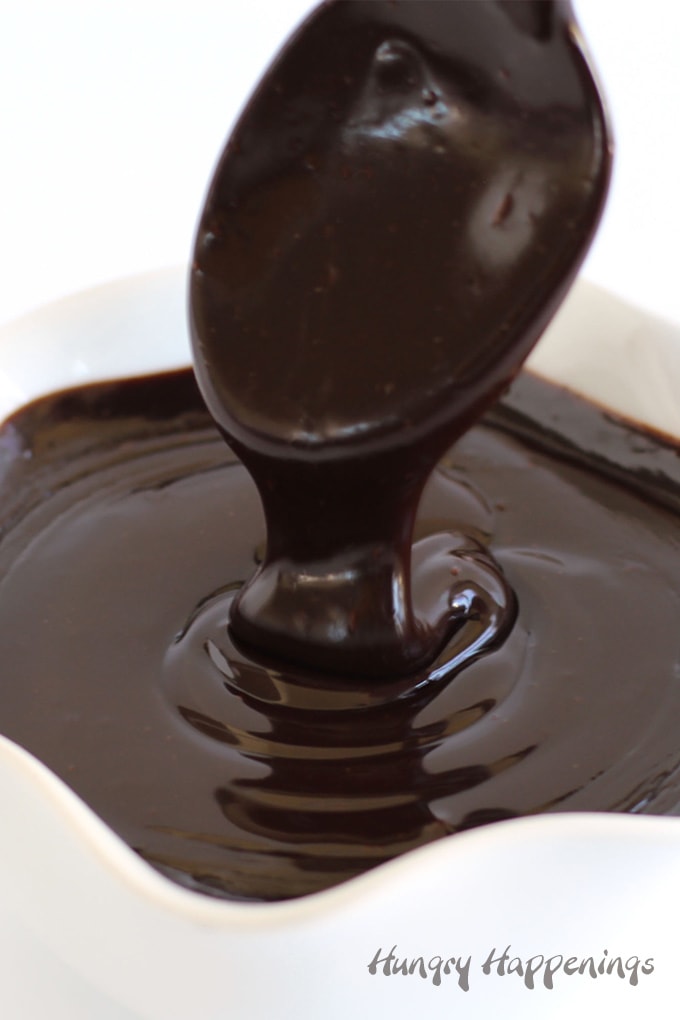
What could taste more heavenly than chocolate ganache, a blend of chocolate and heavy whipping cream?
It has a luxuriously creamy texture and a decadently rich chocolate flavor.
Chocolate Ganache can be scooped and rolled into chocolate truffles, spread or poured over a cake, piped into chocolate shells, used as filling for hot cocoa bombs, or drizzled over desserts like ice cream pie.
It's easy to make but there are some tips and techniques that are important to know so your ganache is creamy and smooth not grainy, gritty, or greasy.
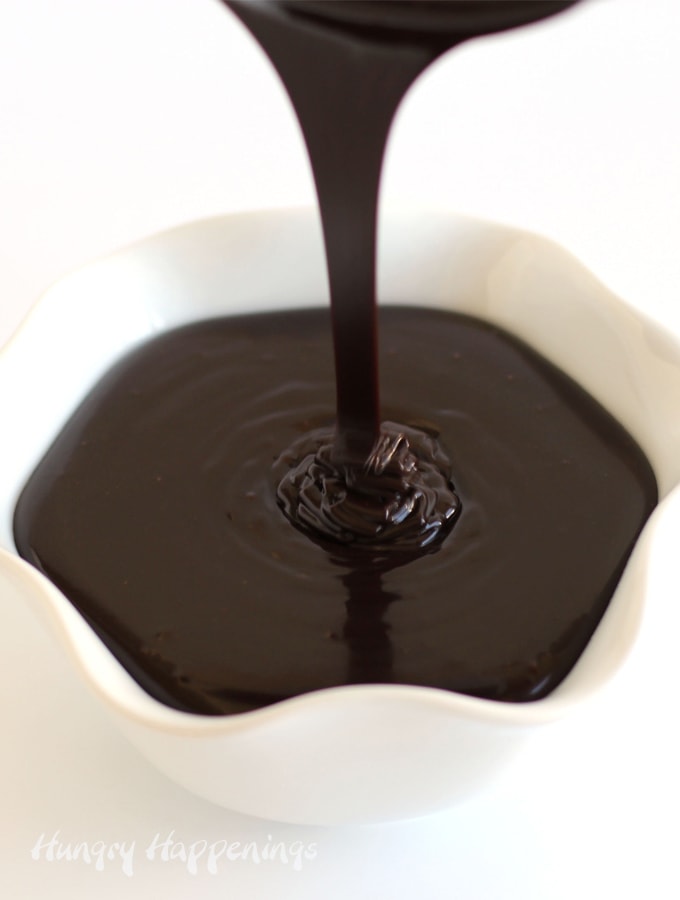
What is chocolate ganache?
- Chocolate ganache is an emulsification of chocolate and a liquid.
- Chocolate ganache is typically made using heavy whipping cream but can be made using fruit puree, butter, olive oil, melted ice cream, egg nog, sour cream, beer, and even water.
- Ganache is very viscous and thin right after it is made but will thicken up as it cools.
- You can adjust the ratio of chocolate to liquid to create fudge-like ganache for rolled truffles, soft ganache for frosting, or thin ganache for glazing.
Chocolate to Liquid Ratios:
- 1:2 ratio of dark (semi-sweet or bittersweet) chocolate to liquid
-
- Example: 8 ounces of chocolate blended with 16 ounces of heavy whipping cream
- This thin ganache can be poured over a cake, drizzled over ice cream, or served as fondue.
-
- 1:1 ratio dark chocolate to liquid
- Example: 8 ounces chocolate blended with 8 ounces of heavy whipping cream
- This thicker ganache can be used as a filling for chocolate candies like Mexican Hot Chocolate Truffles or Turkey Truffles and it also works great to drip down over the edge of a cake.
- It can also be whipped into a light frosting that can be piped onto cupcakes.
- 2:1 ratio dark chocolate to liquid
- Example: 8 ounces chocolate to 4 ounces heavy whipping cream
- This thick, fudge-like ganache is what you will use to make rolled chocolate truffles.
- Once this version of chocolate ganache has cooled and thickened it can also be piped, as is, not whipped, onto cakes, cupcakes, or cheesecakes.
- 2.5:1 ratio dark chocolate to liquid
- Example: 10 ounces chocolate to 4 ounces heavy whipping cream
- This firm ganache is perfect for frosting a cake to be covered in fondant.
Note:
Chocolate ganache ratios change for milk and white chocolate as those two types of chocolate are softer than dark chocolate. See more information below.
How to measure your ingredients:
- I recommend using a kitchen scale to measure the chocolate and cream by weight rather than volume.
- If you don't have a scale then it is best to buy chocolate in the size packages you plan to use like 4-8 ounce bars or bags.
- You can measure the cream using a liquid measuring cup but weighing it is more precise.
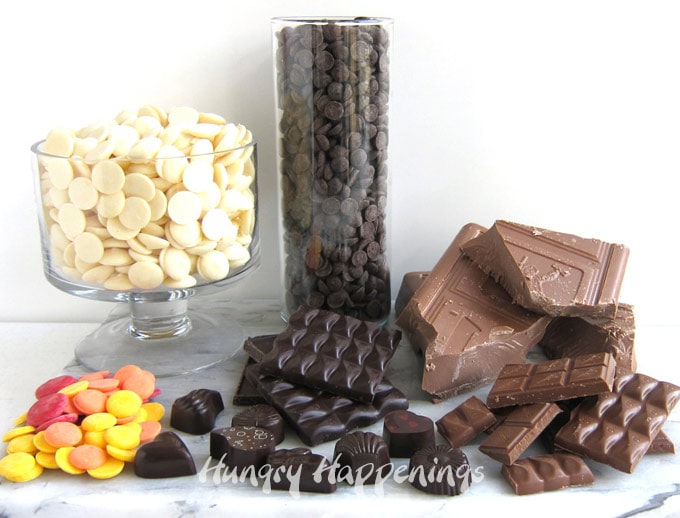
Choosing chocolate to make ganache.
When you are making chocolate ganache it is vitally important that you use chocolate that you really love to eat straight out of the package as you will really taste the chocolate in this recipe.
Just because a bar of chocolate is expensive does not mean you will like its flavor or if it's inexpensive you won't.
I personally am not a fan of bittersweet chocolate (I don't like coffee either). I prefer milder semi-sweet chocolate so that's what I use to make my chocolate ganache. If you enjoy the bitter flavor of darker chocolate, then, by all means, use it in this recipe.
Just note that:
- Dark chocolate (semi-sweet or bittersweet) contains chocolate liquor (a mixture of cocoa solids and cocoa butter) and sugar.
- The higher the percentage of chocolate liquor means the more intensely flavored the chocolate ganache will be.
- It is worth noting that using chocolate with more than 75% chocolate liquor to make chocolate ganache can be problematic as the ganache is more prone to breaking and becoming greasy.
- I recommend using chocolate that is between 50-60% cocoa if you prefer a mellow chocolate ganache.
- Burgundy Chocolate made by Peter's (my favorite!)
- Callebaut semi-sweet chocolate
- If you use chocolate with a higher cocoa content, between 60-72%, your chocolate ganache will have a more robust and more bitter chocolate flavor.
- The higher the percentage of chocolate liquor means the more intensely flavored the chocolate ganache will be.
- Milk Chocolate contains chocolate liquor, sugar, and milk.
- The milk in the milk chocolate makes the chocolate softer than dark chocolate so you will need to adjust the ratio of chocolate to cream in the ganache recipe.
- For instance, if you plan to make thick ganache to make rolled truffles you'll need 2.5:1 ratio of milk chocolate to cream.
- Peter's Ultra Milk Chocolate (my favorite!)
- Callebaut Milk Chocolate Callets (also really delicious)
- White Chocolate contains cocoa butter, sugar, and milk.
- Because white chocolate does not contain any cocoa solids it is the softest of all the chocolates needing a 3:1 ratio of white chocolate to cream when making rolled chocolate truffles.
- White chocolate is the most prone to breaking when made into ganache.
- White chocolate ganache can easily become greasy, so you will need to be very careful when heating your cream that it does not get too hot (see details below).
- Compound Chocolate (also known as confectionery coating, Candy Melts, Almond Bark, and Melting Wafers) contains vegetable oil, typically palm kernel oil, and is meant to harden more quickly than pure chocolate. If you use dark cocoa candy melts to make ganache use the same ratio as you would if using dark chocolate. Likewise for milk or white.
- I typically do not recommend using compound chocolate to make dark or milk chocolate ganache as the flavor and texture of pure chocolate made with cocoa butter is far superior, but it definitely can be used if it is what you can afford or have on hand.
- I actually enjoy the flavor of white compound chocolate and use it often when making white ganache.
You can find my recommended chocolates at Amazon.com. I earn a small commission at no extra cost to you when you use the links in this post.
 Peters Burgundy Semisweet 6...Shop on Amazon
Peters Burgundy Semisweet 6...Shop on Amazon  Callebaut Belgian Dark Couv...Shop on Amazon
Callebaut Belgian Dark Couv...Shop on Amazon  Callebaut 70% dark chocolat...Shop on Amazon
Callebaut 70% dark chocolat...Shop on Amazon  Lindt EXCELLENCE 70% Cocoa ...Shop on Amazon
Lindt EXCELLENCE 70% Cocoa ...Shop on Amazon  Peter’s Ultra 160 Milk Ch...Shop on Amazon
Peter’s Ultra 160 Milk Ch...Shop on Amazon  Callebaut Milk Callets 33.6...Shop on Amazon
Callebaut Milk Callets 33.6...Shop on Amazon  GHIRARDELLI Premium White C...Shop on Amazon
GHIRARDELLI Premium White C...Shop on Amazon  Lindt CLASSIC RECIPE White ...Shop on Amazon
Lindt CLASSIC RECIPE White ...Shop on Amazon  Callebaut W2 28% White Choc...Shop on Amazon
Callebaut W2 28% White Choc...Shop on AmazonChocolate Bars, Blocks, Pistoles, Wafers, or Callets
- Pure chocolate is available in thick 5-10 pound blocks, thin 4 to 8-ounce candy bars, oval pistoles, large round wafers, or small round callets.
- You can use any of these to make your chocolate ganache.
- If you are using chocolate bars, blocks or large wafers you will want to finely chop them before making the chocolate ganache recipe.
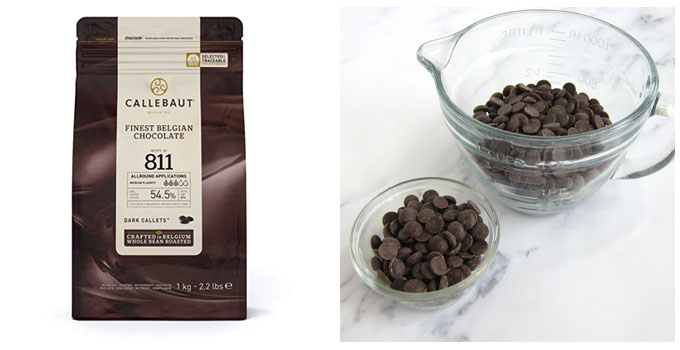
NOTE about chocolate callets:
- Chocolate Callets, like the Callebaut Chocolate Callets pictured above, look like chocolate chips but they are not!
- Callets (a brand name of Callebaut) are couverture chocolate which is meant to melt at low temperatures, unlike chocolate chips that contain emulsifiers and are meant to maintain their shape even at high temperatures (like 350° when baked in chocolate chip cookies).
Can I make ganache using chocolate chips?
- Yes, you can, but I do not suggest using chocolate chips if you can use bars, blocks, or callets instead, to make chocolate ganache because chips have emulsifiers in them, which keep them from melting at low temperatures.
- You'll see in the recipe below that you pour hot cream over your chocolate and allow it to melt. If you use chocolate chips to make your ganache, the cream will need to be very hot in order to melt the chocolate chips.
- Overly hot cream can cause your chocolate ganache to break (become greasy, gritty, or grainy).
- See below for details on broken ganache and how to fix it.
- Now that is not to say that people don't use chocolate chips to make ganache. I actually have on occasion, knowing that many of my readers will find it convenient to do so. It does work if you are careful.
- I've seen many recipes, even some very popular ones, that use chips. But if you look closely at the pictures you will notice that many of those truffles have sugar crystals in them which means they are gritty instead of smooth.
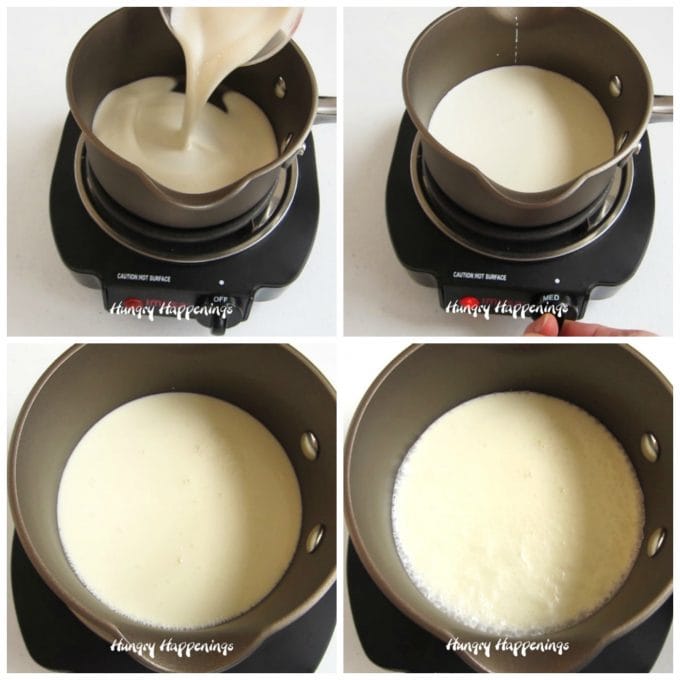
Heavy whipping cream:
- Chocolate ganache is typically made using heavy whipping cream as the liquid.
- Plain whipping cream contains 30% butterfat while heavy whipping cream (or heavy cream) contains 36% or more, so be sure to grab the carton of "heavy whipping cream" instead of "whipping cream."
- If you are not located in the United States, just look for a cream that contains about 36% fat.
Heating the cream and creating an emulsion:
I have seen a lot of recipes that tell you to boil the cream. DO NOT ALLOW THE CREAM TO COME TO A RAPID BOIL!
- As cream boils the water evaporates leaving you with a higher ratio of fat to water.
- When creating chocolate ganache you need to create a fat-in-water emulsion and if the ratio of fat to water gets too high, your ganache will break.
- Casein, a group of proteins in milk, acts as an emulsifier in cream, helping to keep the fat and water from separating. The casein will also help when creating an emulsion when making ganache.
- When heating the cream, you just want to bring your cream to a simmer which means bubbles just begin to form around the edge and into the center of the pan otherwise you can boil off too much water, leaving too much fat.
- Chocolate is extremely sensitive to temperature changes as the cocoa butter in the chocolate melts completely between a range of 87°F to 91°F (30°C t0 33°C).
- The best temperature for ganache to properly emulsify and prevent breaking is between 90°F and 93°F.
- If the temperature of your ganache goes too high, it will cause the fats to separate. This results in a broken ganache. So it is very important that you do not boil your cream and allow it to get too hot.
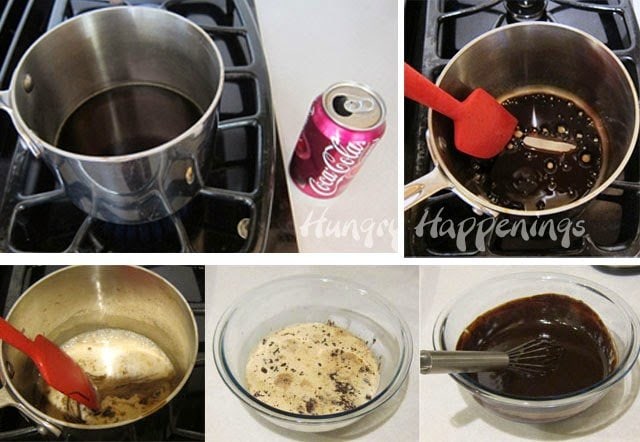
Other liquids you can use to make chocolate ganache.
You can use a variety of liquids to make chocolate ganache. Check out some of these ganache recipes that are made using a variety of liquids:
- egg nog ganache
- vanilla ice cream ganache
- chocolate raspberry ice cream ganache
- salted caramel ice cream ganache
- hazelnut coffee ganache
- almond milk ganache
- Cherry Coke ganache
- chocolate cashew ganache
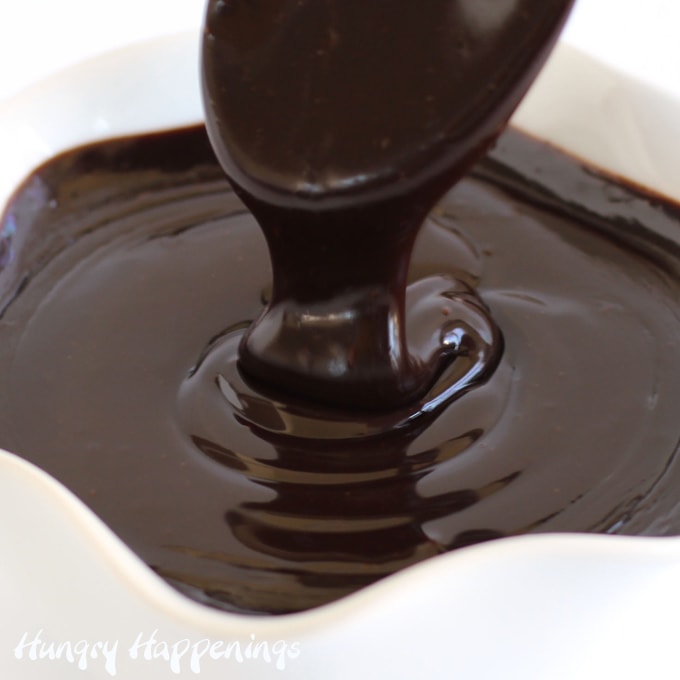
How to make Chocolate Ganache
Confectioner's Method
- The absolute best way to make perfect chocolate truffles is to temper your chocolate (heat it to 115° F or 45° C, seed it with solid tempered chocolate, agitate and cool it to a working temperature of 90-91° or 32° C) then to emulsify it with cream that has been heated and cooled to 104° Fahrenheit (40° C), but that is more work than most people will go through to make a simple 2-ingredient recipe.
So, let me show you three simple ways to make chocolate truffles.
3 easy chocolate ganache making methods:
I'll start with the most common method, but this is my least favorite method and I'll tell you why below.
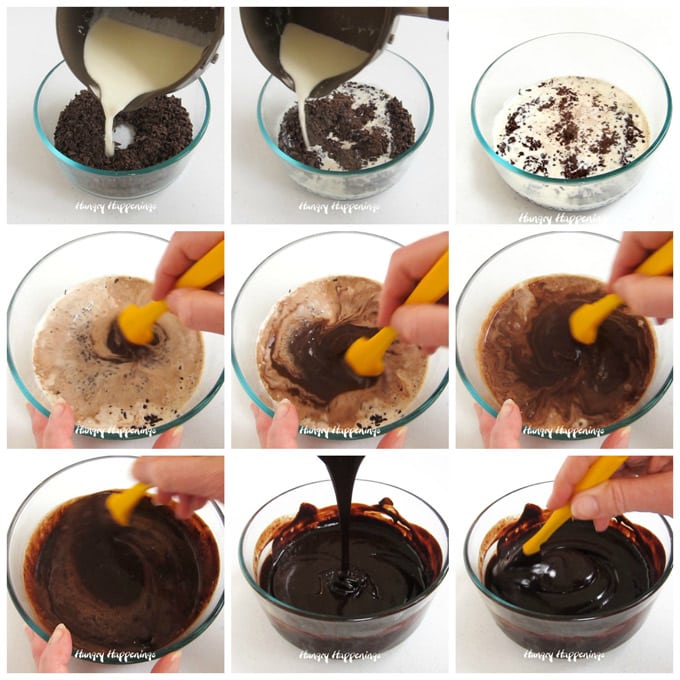
Make chocolate ganache in a bowl.
- Use a bowl and spoon or rubber spatula to make your ganache.
- It is vitally important that you finely chop, or better yet grate, your chocolate into evenly-sized small pieces. I'm talking tiny shavings, not chunks. You want the pieces to be as uniform as possible so that they melt evenly.
- Pour that chocolate into a shallow bowl. The thinner the layer of chocolate, the better.
- Create a well in the center of the chocolate (a hole where you can see the bottom of the bowl). This will allow the cream to get under the chocolate more easily.
- Heat your cream over medium heat to a simmer on the stove, just until bubbles begin to form.
- Immediately pour the hot cream over the chocolate, making sure it covers all of the chocolate.
- If you have patches of exposed chocolate, gently push it down into the cream, but do not stir yet!
- Let the chocolate and cream sit, undisturbed for about 3 minutes to allow the chocolate to begin to melt.
- Then begin stirring the mixture in small circles in the center of the bowl.
- As the chocolate and cream start to darken and come together you can begin to make your circle bigger.
- Continue stirring until the cream and chocolate come together then widen the circle again and continue until the entire bowl of cream comes together.
- Be sure to scrape the bottom and sides of the bowl.
- Then quit stirring as soon as the chocolate and cream come together to create a silky smooth ganache.
- If you overmix the ganache it can become grainy.
Why is this my least favorite method:
- By using this method you can end up with small bits of unmelted chocolate in your ganache.
- The best way to break up the lumps of unmelted chocolate is to use an immersion blender or food processor, but if you have either of those tools you should follow the instructions below for making your chocolate ganache.
- You can reheat the ganache to melt the chocolate chunks, just be careful you don't overheat it.
- You can reheat it using a double boiler.
- To create a double boiler fill a pan with 1 inch of water then set the pan over low heat.
- Snuggly fit the bowl of chocolate ganache into the top opening of the pan, making sure the bowl does not touch the water.
- Stir continuously until most of the chocolate melts.
- Remove from the heat and continue to stir until melted.
- If you overheat the ganache at this point it can break.
- You can also stir too vigorously or for too long, thus cooling the chocolate and cream too quickly.
- Also, if you mix excessively after the ganache has cooled down below 90° Fahrenheit it will become grainy.
- Alternatively, you can heat the chocolate ganache in the microwave, for 5-10 second bursts of high power.
So with all of these issues, you can see why this isn't the best method.
Let's try my favorite method.
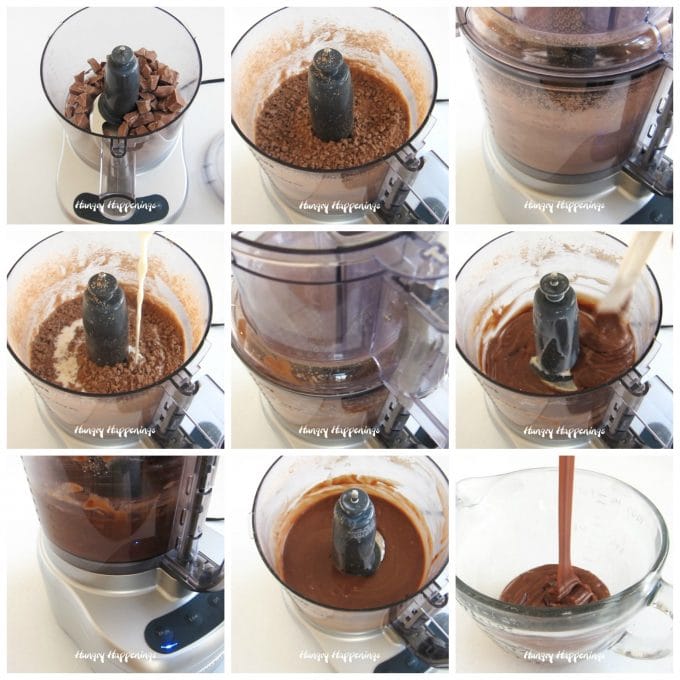
Make Chocolate Ganache in a food processor.
- Use your food processor to either finely chop or grate your chocolate.
- Roughly chop blocks or chocolate bars into ¼-1/2 inch pieces or use wafers, pistoles, or callets.
- Place the chocolate in the bowl of the food processor and pulse until you get fine crumbs of chocolate.
- OR, place blocks or bars in the top of the food processor fitted with a grating disc. Pulse, allowing the grated chocolate to fall into the bowl.
- If you use this method you'll need to pour the grated chocolate into another bowl, so you can put the metal blade into the food processor. Then put the chocolate back in the food processor and follow the instructions below.
- Pour hot cream (that has been brought to a simmer on the stove) over the chocolate, close the lid, and pulse two times.
- Remove the lid and scrape down the side of the bowl being sure to scrape in the corners of the bowl.
- Return the lid and wait for 2-3 minutes to allow the hot cream to melt the chocolate.
- Then pulse 2-3 times just until the ganache comes together.
- Do not overmix or you will create lots of air bubbles in your ganache.
Why is this my favorite method?
This is my favorite method because the blade of the food processor chops the chocolate so I don't have to manually chop my chocolate plus it continues to chop the chocolate as it emulsifies the chocolate and cream into a very smooth ganache.
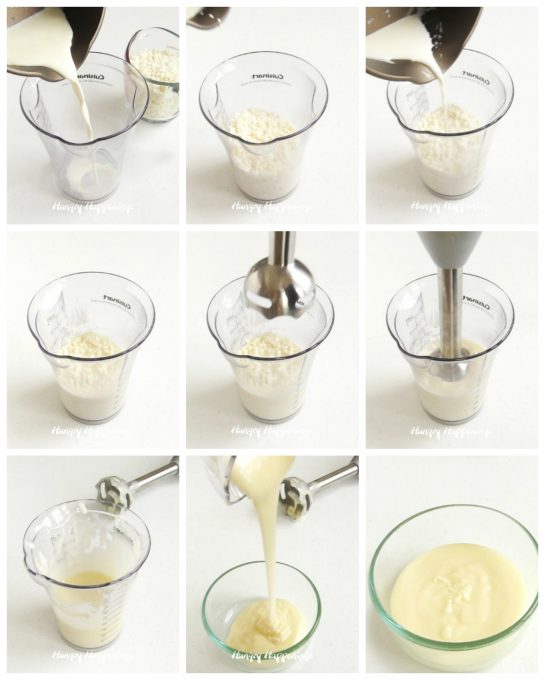
An immersion blender works similarly to make the ganache but the blades are quite a bit smaller than those in a food processor and not powerful enough to chop the chocolate, so you have to chop it by hand.
Make ganache using an immersion blender.
- Pour ¼ of your hot, simmered, heavy whipping cream into a tall immersion blender cup or a mixing bowl.
- Add the chocolate.
- Pour the remaining cream over top.
- Let sit for about 2 minutes to allow the chocolate to begin to melt then pulse until the ganache comes together.
- Scrape the bottom and sides of the cup and blend again just to be sure all of the chocolate has been blended into the cream.
- Pour into a shallow bowl, cover, and set aside at room temperature until firm.
I particularly like this method when I'm making small batches of chocolate ganache.
Should I add butter to my ganache?
- Butter is often added to ganache to enhance the creamy texture and to add another flavor note.
- I do not add butter to my ganache because I always use high fat cream so butter is not necessary. Actually, the added fat can lead to your ganache separating and becoming greasy.
- If you cannot find heavy whipping cream and you use a cream with less fat then it might be a good idea to add butter.
- If you do decide to add butter, be sure to soften the butter at room temperature, then add it in small pieces after the chocolate and cream have been emulsified together.
Should I add invert sugar or glucose?
- Invert sugar and glucose will help to keep your ganache from breaking and becoming grainy and will help enhance the shelf life.
- Most professional chocolatiers will add both to their ganache recipes, but these products are not readily available to the home cook, so I do not include them in my truffle recipes.
- If you do plan to make chocolate truffles to sell, and you need to increase the shelf life then I recommend you use recipes that include these ingredients.
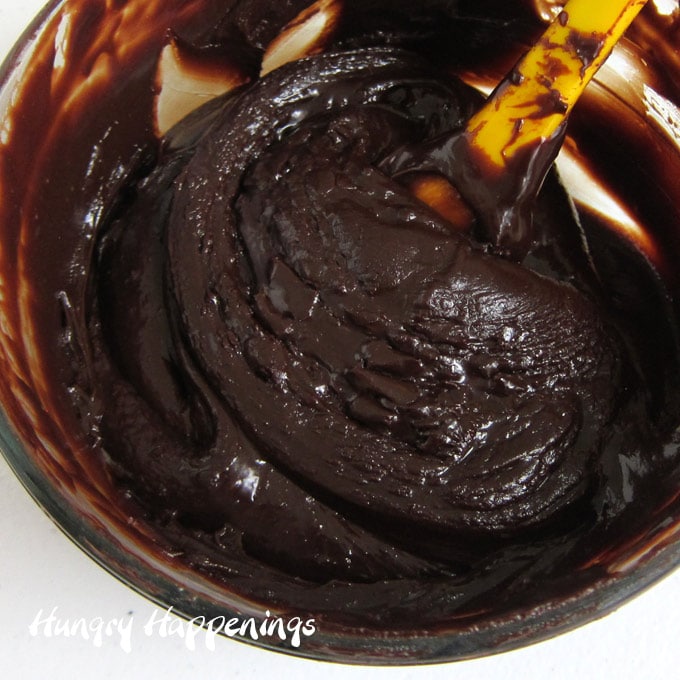
How to fix broken ganache that is grainy or greasy?
If you immediately see that your ganache is broken because it looks curdled or greasy, you can use the methods listed below to fix it.
Corn Syrup Method:
- Spoon 1-2 tablespoons of broken ganache into a bowl.
- Bring 2 tablespoons of light corn syrup to a boil.
- Whisk very small amounts of corn syrup at a time into the broken ganache.
- Keep adding corn syrup, a little at a time, until that ganache is smooth and shiny again.
- Stop adding corn syrup as soon as the ganache is shiny and smooth. You may only need to add 1 tablespoon of the corn syrup to re-emulsify the broken ganache.
- Now, continue whisking this shiny ganache, and slowly add the broken ganache until it is all incorporated and smooth.
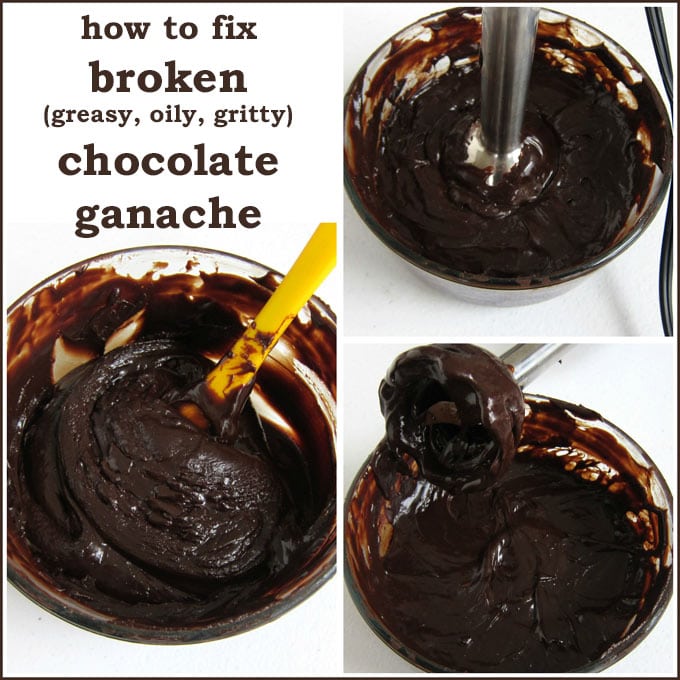
Immersion Blender Method:
- If your ganache is still warm and is broken you can use an immersion blender to bring your broken ganache back together.
- Insert the stick blender into the ganache and turn it on allowing it to emulsify the ganache.
- I highly recommend using a food processor or immersion blender to make your ganache as you probably won't have issues with it breaking, to begin with.
Milk Method:
- Heat a small amount of low-fat milk just to a simmer.
- Slowly drizzle the milk into the broken ganache, whisking continuously, just until it comes back together.
- Low-fat milk has a high water content which will help to balance the amount of fat in a broken ganache but any milk you have on hand will work.
- The disadvantage of adding milk to a broken ganache is that it will make your ganache thinner, which can be a problem if you plan to use it to make rolled truffles.
- If you are using it to make rolled truffles it might be too soft. You can slowly stir in some melted and tempered chocolate to thicken it up.
Heating/Cooling Method:
- Divide your broken ganache in half.
- Pour half into the top bowl of a double boiler and heat to 130° Fahrenheit (54° C).
- Set the other bowl of broken ganache over a bowl of ice and stir until the ganache cools to 60° Fahrenheit (16° C).
- Do not refrigerate to cool the ganache as it won't cool evenly.
- Slowly stream the warm ganache into the cool ganache, continuously whisking, until it comes together and becomes smooth and glossy.
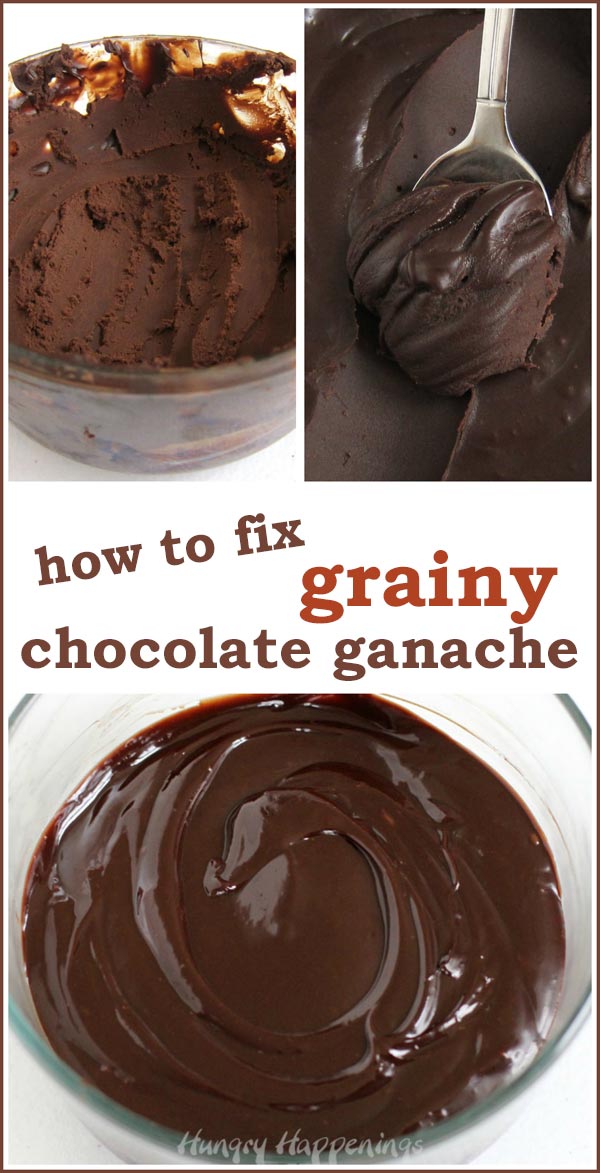
Sometimes you won't realize there is a problem with your ganache until it has firmed up.
If it looks really dull (top left image) then there is a problem, but it might look glossy and still be grainy (top right image). You might need to taste the ganache in order to determine if it has become grainy, but most likely you will see sugar crystals in the ganache and realize it's grainy.
Fixing grainy, gritty, ganache:
- Your ganache can become grainy if it was over stirred once it cooled below about 90° Fahrenheit (32° C) or if it was cooled in the refrigerator.
- To fix this, slowly warm it using a double boiler until melted and use one of the methods listed above to fix a broken ganache.
Use other liquids to make ganache:
You can use other liquids to make your chocolate ganache in place of the heavy whipping cream. You can even use water, but below are some of my favorites.
- coffee ganache: Use the same ratios listed above when swapping out coffee for cream or use half coffee and half cream for a more mellow flavor. I used coffee ganache to make my Snowman Truffles filled with Chocolate Hazelnut Coffee Ganache.
- fruit purée ganache: The ratio of purée to chocolate will depend on the thickness of the purée. If it is as thick as cream, use the same ratio. If it is thinner, use additional chocolate or use half purée and half cream.
- ice cream ganache: Melt any flavor ice cream then measure it and use the same ratio of chocolate to cream as listed above. I used ice cream ganache to make Chocolate Raspberry Ice Cream Truffles and Salted Caramel Ice Cream Truffles.
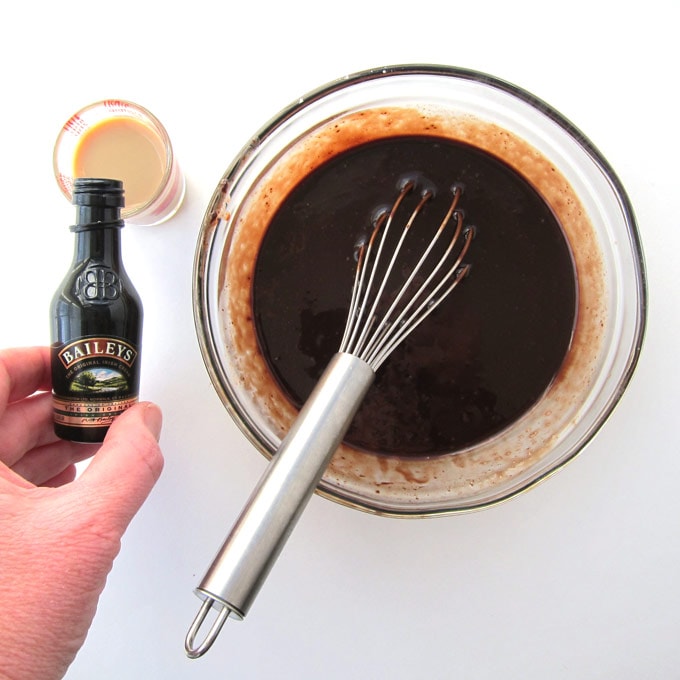
Other flavorings:
- aromatics: tea leaves, fresh herbs, spices (like cinnamon, cloves, ginger, cardamom)
- Add the aromatics to the cold cream then heat the cream just until the first bubbles begin to form.
- Remove the cream from the heat and let the aromatics steep for 15 minutes. Covering the saucepan will keep the liquid from evaporating and will enhance the flavor.
- Pour the cream through a fine-mesh strainer to remove the larger pieces of aromatics.
- Bring the cream to a simmer before pouring it over the chocolate.
- I used this technique to make a Chocolate Tart Infused with Salted Caramel Tea.
- liquor: Bailey's Irish Cream, Kirsh, Chambord, Peppermint Schnapps, etc.
- Just before your ganache comes together, pour in the liquor and continue to stir until glossy and smooth.
- You must replace the liquor for a portion of the cream.
- If using 4 ounces (½ cup) of cream and 8 ounces of chocolate, and you want to add 2 tablespoons of liquor, then remove 2 tablespoons of the cream from the recipe.
- The flavor of liquor may intensify as the truffles age.
- Speaking of age, liquor will also prolong the shelf life of a chocolate truffle.
- I used this method to create Penguin Truffles filled with White Chocolate Amaretto Ganache.
- candy oils: LorAnn candy oils come in dozens of flavors like cherry, banana, cola, raspberry, and more.
- Just before your ganache comes together, pour in the candy oil and continue to stir until glossy and smooth.
- Start with a ¼ - ½ teaspoon then taste. Add more as needed.
- coffee flavoring: any flavoring you can add to coffee can also be used to flavor ganache.
Video
You can watch this Chocolate Truffles Video in order to see all three methods of making chocolate ganache in a bowl, in a food processor, or using an immersion blender.
Printable Recipe
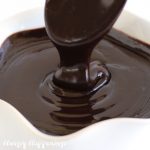
Blend chocolate and heavy whipping cream together to create silky smooth chocolate ganache which can be used to make frosting, glaze, fondue, or chocolate truffles.
- 8 ounces semi-sweet chocolate
- 16 ounces heavy whipping cream
- 8 ounces semi-sweet chocolate
- 8 ounces heavy whipping cream
- 8 ounces semi-sweet chocolate
- 4 ounces heavy whipping cream
- 10 ounces semi-sweet chocolate
- 4 ounces heavy whipping cream
-
Finely chop the chocolate and place it in a large shallow bowl or in the bowl of a food processor.
-
Heat the heavy whipping cream in a saucepan set over medium heat just until it begins to simmer (bubbles begin to form).
-
Pour the hot cream over the chocolate. If you have patches of exposed chocolate, gently push it into the cream but do not stir!
-
Let the chocolate and cream sit, undisturbed for 3 minutes to allow the chocolate to begin to melt.
-
Then begin stirring the mixture in small circles in the center of the bowl. As the chocolate and cream start to darken and come together you can begin to make your circle bigger.
-
Continue stirring until the cream and chocolate come together then widen the circle again and continue until the entire bowl of cream comes together. Be sure to scrape the bottom and sides of the bowl.
-
Then quit stirring as soon as the chocolate and cream come together to create a silky smooth ganache.
-
Cover the bowl of ganache with a tight-fitting lid or press a piece of plastic wrap onto the top surface of the ganache and set it aside at room temperature.
-
Pour hot cream over the chocolate, close the lid, and pulse two times.
-
Remove the lid and scrape down the side of the bowl being sure to scrape in the corners of the bowl.
-
Return the lid and wait for 2-3 minutes to allow the hot cream to melt the chocolate.
-
Then pulse 3-6 times until the ganache comes together.
-
Pour the ganache into a bowl, cover, and set aside to cool.
-
Do not scrape any thick chocolate from the bottom of the food processor, just allow the liquid ganache to fall into the bowl leaving behind any that is too thick.
-
Use the ganache as a glaze, fondue, filling, or frosting, or scoop and roll it into truffles.
- MILK CHOCOLATE GANACHE - be sure to increase the amount of chocolate, if using milk chocolate. Example use 2.5:1 ratio of milk chocolate to cream to make thick, fudge-like ganache to roll truffles.
- WHITE CHOCOLATE GANACHE - be sure to increase the amount of chocolate, if using white chocolate. Example use 3:1 ratio of white chocolate to cream when making rolled chocolate truffles.
- Chocolate ganache can be stored at room temperature for up to 2 weeks if covered with a tight-fitting lid.
- You can increase the shelf life to 3 weeks if you refrigerate the ganache.
- You can even freeze chocolate ganache for up to 3 months. Thaw in the refrigerator overnight.
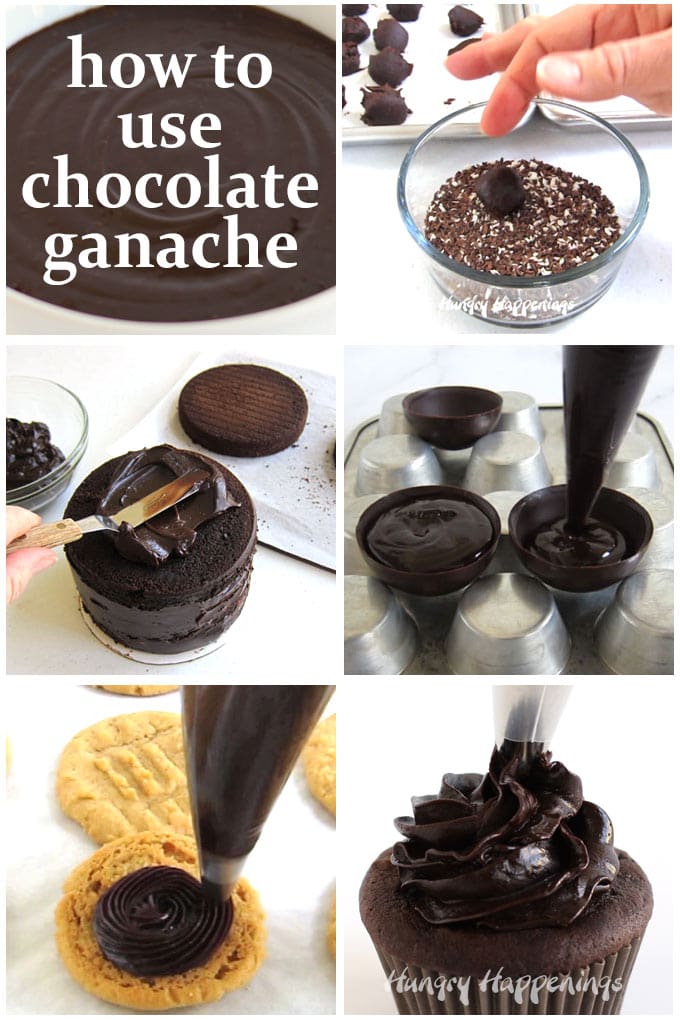
What to make with chocolate ganache?
- Scoop and roll chocolate ganache to make chocolate truffles.
- Frost a cake with chocolate ganache.
- Pipe the ganache into hollow chocolate spheres to make hot chocolate bombs
- Spread or pipe in between two peanut butter cookies.
- Pipe ganache frosting in a big swirl over a delicious chocolate cupcake.
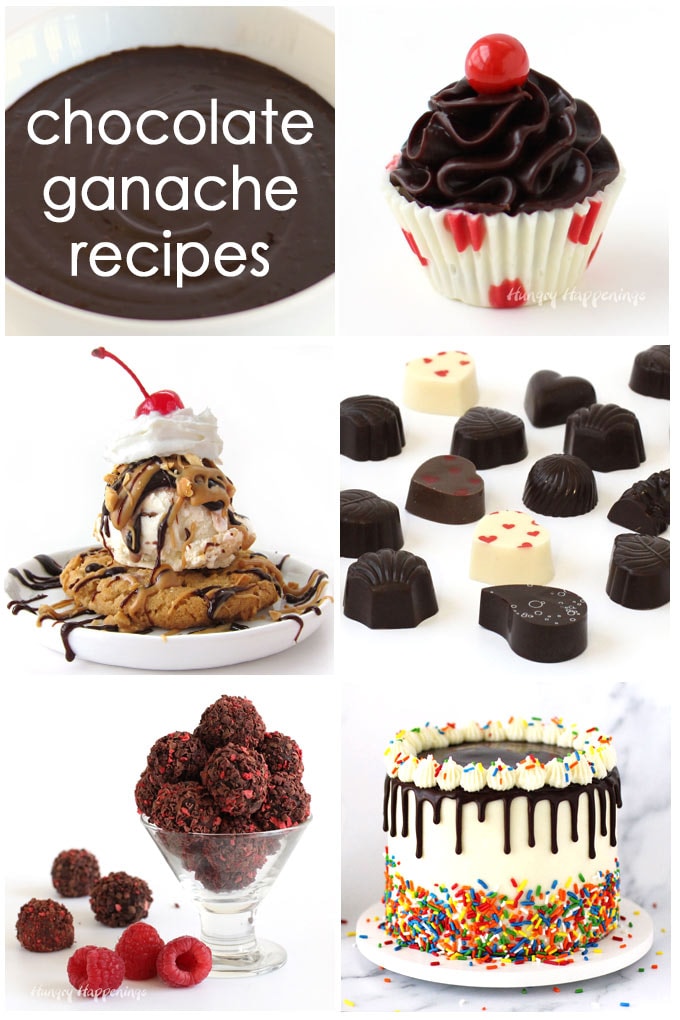
Recipes using Chocolate Ganache
- Make Mini Chocolate Cupcake Truffles by piping the ganache into mini white chocolate cups.
- Drizzle chocolate ganache and peanut butter over a Peanut Butter Cookie Ice Cream Sundae.
- Fill chocolate shells to make beautiful chocolate truffles.
- Scoop and roll chocolate ganache (made using raspberry puree) into chocolate shavings and crushed freeze-dried raspberries to make Chocolate Raspberry Truffles.
- Make a festive Sprinkle Birthday Cake with chocolate ganache dripping down over the top and sides of the cake.

- Dip peanut butter fudge hearts in chocolate ganache to make delicious Chocolate Peanut Butter Fudge Hearts.
- Pour it over a fruit pizza to make a Chocolate Dipped Fruit Pizza Strawberry.
- Dip chocolate cookies in ganache to create:
- Pipe over top of Almond Nougatine Spoons.
- Spoon it over top of Mini Chocolate Cheesecakes.
- Drizzle ganache over raspberry ice cream pie or piped into a design to create Jack Skellington Cheesecakes, pipe it into
- Mexican Hot Chocolate Skull Truffles, or just eaten by the spoonful.
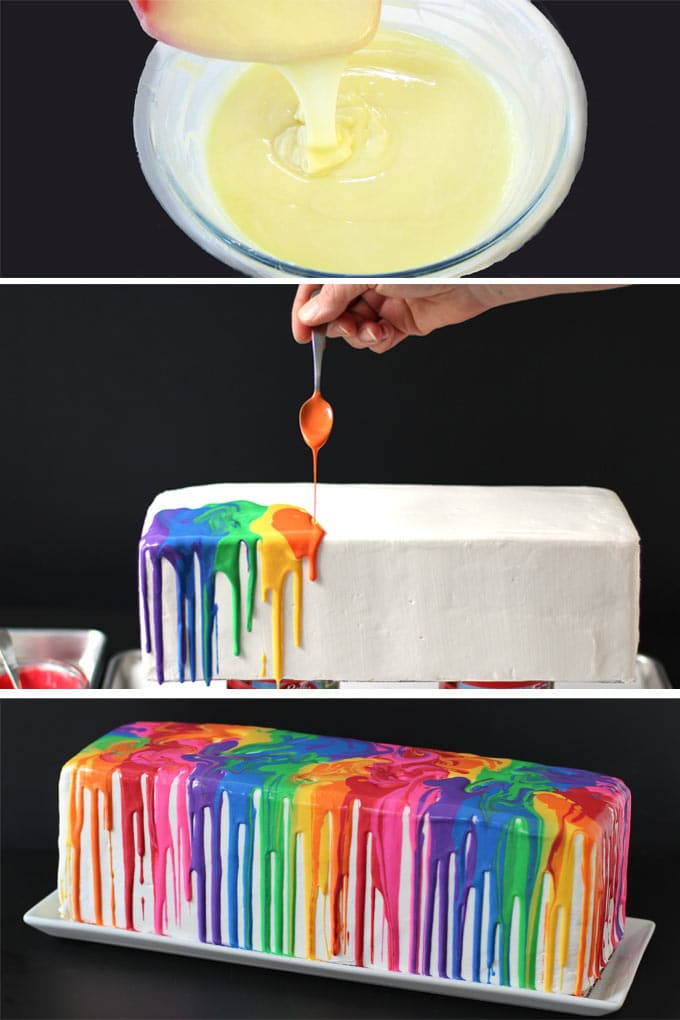
Coloring White Chocolate Ganache
- One of the things I like best about white chocolate ganache is that it can be colored using liquid, gel, or paste food coloring. If you use liquid food coloring, it will make the ganache more fluid, so you may need to adjust the amount of white chocolate so that your ganache isn't too thin.
- Start by adding a few drops of coloring to your bowl of white chocolate ganache. Add more until you get the desired color.
- Melting Rainbow Cake
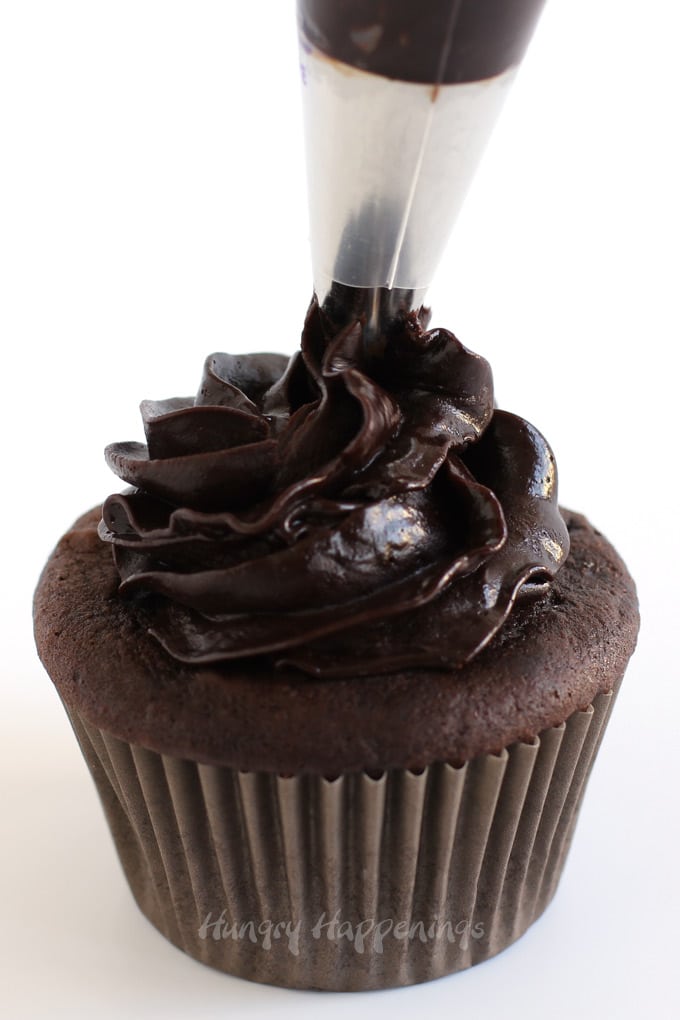
Chocolate Ganache Frosting
- You can simply allow fudge-like chocolate ganache (made using a 2:1 ratio of chocolate to liquid) to cool just long enough for it to become thick enough to pipe onto a cupcake or you can create or you can make a thinner ganache using a 1.5:1 ratio of chocolate to liquid, allow it to cool, then beat it using an electric mixer until light and fluffy.
- Note that chocolate ganache frosting will firm up quite a bit. It will not be as soft as chocolate buttercream frosting, but it tastes amazing and will melt in your mouth when you bite into it.
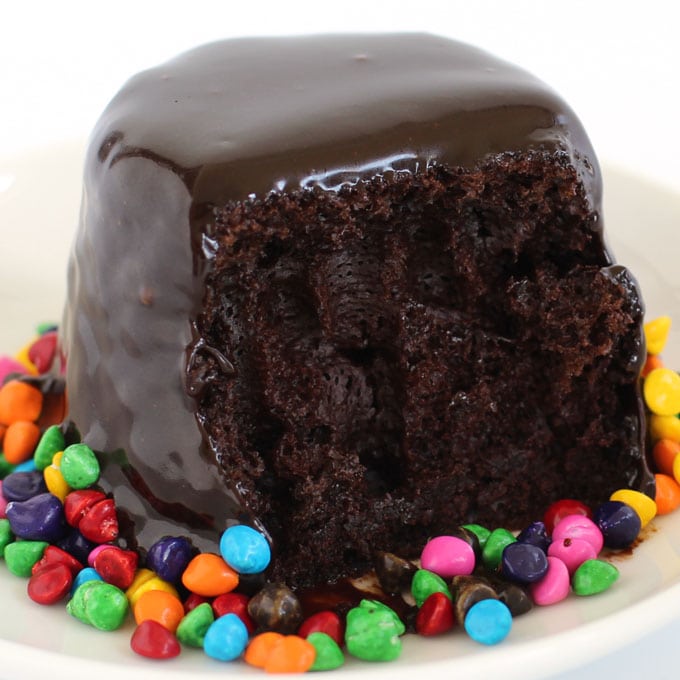
Chocolate Ganache Glaze
- Use a 1:2 ratio of dark (semi-sweet or bittersweet) chocolate to liquid to create a glaze for cakes.
-
- Example: 8 ounces of chocolate blended with 16 ounces of heavy whipping cream
- This thin ganache can also be drizzled over ice cream or ice cream pie or simply served as fondue or dip.
- If you want to ensure your chocolate glaze remains shiny, you can add 1-2 tablespoons of light corn syrup.
-
DO NOT refrigerate your chocolate ganache to make it cool faster!
- As chocolate ganache cools, cocoa-butter crystals begin to form and the ganache begins to set. If you cool the ganache too quickly, the cocoa butter won't form uniform crystals.
- Then when the chilled ganache is returned to room temperature it can be too soft or even become greasy.
- Also, some of the fat crystals will have become too large making your ganache have a grainy texture.
It is best to allow the chocolate ganache to cool at room temperature.
To speed up the process, you can pour the ganache in a thin layer in a glass bowl. The thicker the layer, the longer it will take to firm up.
How to store chocolate ganache?
- A bowl of chocolate ganache can be covered with a tight-fitting lid or a piece of plastic wrap and set on the counter at room temperature for up to two weeks. Your ganache will retain its creamy texture and delicious flavor if stored at room temperature.
- You can refrigerate a bowl of chocolate ganache for up to 3 weeks, but be sure to press a piece of plastic wrap directly onto the top surface of the ganache before refrigerating it to keep sugar crystals from forming on top.
- You can also freeze chocolate ganache for up to 3 months. Thaw it in the refrigerator overnight before allowing it to thaw on the counter for at least an hour before removing the plastic wrap.
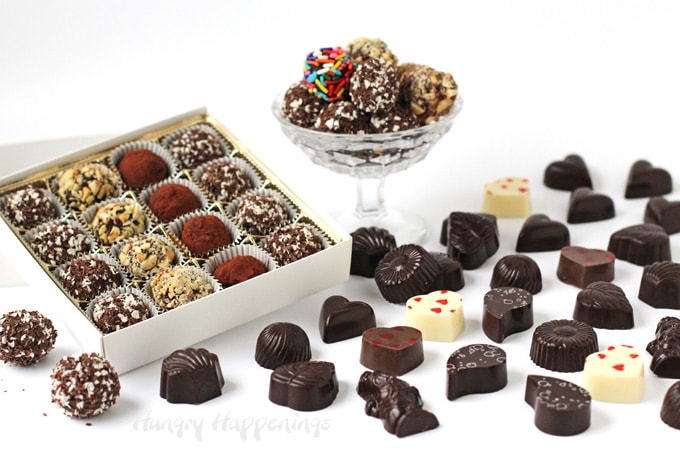
Chocolate Truffle Making Class
- If you'd like to learn more about making chocolate truffles including truffles made using polycarbonate chocolate molds, be sure to check out my chocolate making courses.
- In the online video class, you will learn everything you need to know to make delicious and beautiful chocolate truffles.
- How to make peanut butter? - February 15, 2024
- OREO Penguins - December 20, 2023
- OREO Snowmen - December 20, 2023


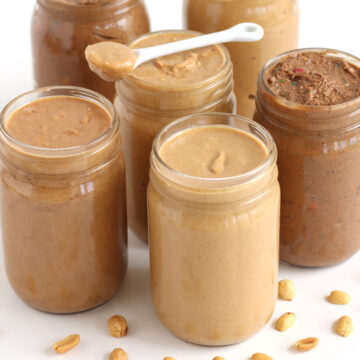

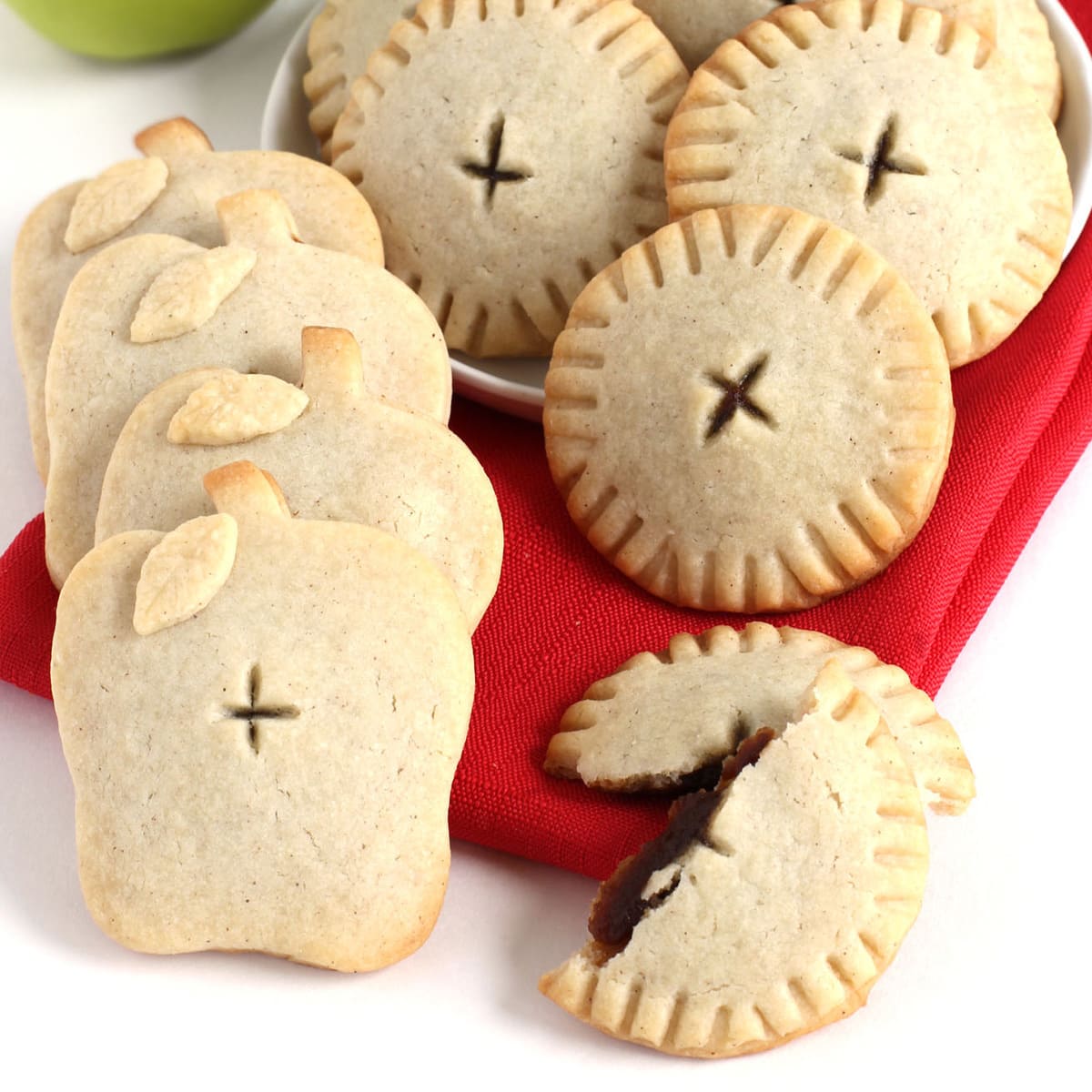
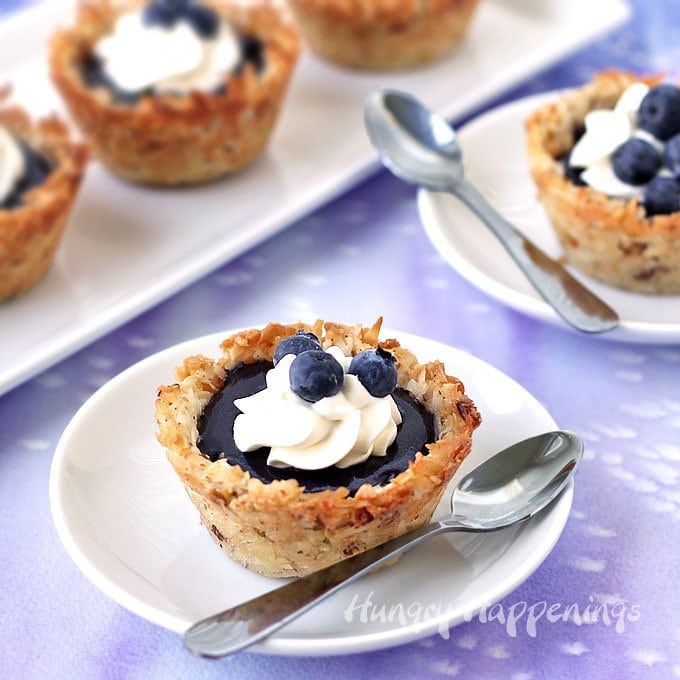
Jen
Hello thank You for all of your tips. My question is my ganache is smooth and creamy the next day but when I’m spooning it to take it out of the bowl and transferred into another bowl or piping bag it starts to harden up. Why is that?
Beth Klosterboer
Ganache thickens as it cools. When you make the ganache to make truffles it get thick enough to scoop and roll. Using other ratios of chocolate to cream will keep it from thickening too much but it will still be thicker than when it's warm. If it is actually hardening, then you probably need to add more cream. You can gently warm the ganache to thin it out and stir in more cold cream to thin it out. I hope this helps.
JoAnn
Hi Beth. I've followed you for quite some time and made many of your fabulous recipes. U have also answered a few of my questions in the past and taught me so many things. I thank you so much for all that.
I have another problem I hope u can help me through. I would like to make pumpkin rolls that can be shelf stable. It would be nice if they can be refrigerated or frozen too, should I choose to do so, but Definatly shelf stable for few days to display. Ideally I wanna use LorAnn cream cheese super strength flavor in the filling for the traditional cream cheese flavor, but am at a loss as to what to use for the filling. My first thought was buttercream, or even a blend of butter and shortening buttercream (maybe even meringue powder in it too?). Then I remembered your ganache recipe, tutorial, and tips. Could white chocolate ganache (or use vanilla confectionery coating to make ganache) and flavor it with the flavoring? Would the texture throw off the pumpkin roll? Or what about whipped ganache?
I really really hope you can give me some insight on this. Im racking my brain!!! Look forward to hearing from you. Thanks!
Beth
Hi JoAnn,
I'm so happy to hear you have enjoyed making many of my recipes! I think using white chocolate ganache flavored with the cream cheese flavoring would be delicious in a pumpkin roll. If you use 12 ounces (340.19 grams) white chocolate and 1/3 cup (80 grams or 79 ml) heavy whipping cream, you'll get a wonderfully creamy ganache that would make a great filling for the pumpkin roll. You can increase the quantity as needed to make enough filling. I used this ratio and this ganache to top my Caramel Snickerdoodle Bars that were made in a 9x13-inch pan. You can see the thickness of the ganache in pictures in the blog post here - https://howtomakeeasycookies.com/easy-caramel-snickerdoodle-bars/
That should give you an idea of how much you might need for one pumpkin roll.
Let me know how it works out.
JoAnn
Wow those snicker doodle bars look amazing!
I read on this post that if I were to use vanilla almond bark, (I have a specific brand I like the flavor of) the ratios fall under the dark chocolate category I believe it said? If I were to try that, what ratio would I use to get the right consistency ganache for the pumpkin roll? I may try n make one batch of ganache with white chocolate and one with almond bark and see which one I like better.
I thank you so much for taking the time to reply and help by the way. You are truly an inspiration! I'm an experienced baker and candy maker. Limited experience with chocolates tho. Your work amazes me.... inspires me..... And it tastes amazing too!
Beth
If you use vanilla almond bark it will firm up a bit more than ganache made using pure white chocolate so I'd suggest you use a little more heavy whipping cream so that it's still soft enough to roll inside the pumpkin roll. I'd suggest combining 12 ounces of vanilla almond bark with 1/2 cup of cream. It would be a good idea to experiment with it to see how it firms up. I always suggest leaving the ganache and room temperature to firm up. It's creamier than ganache that is refrigerated while it's warm. It might take a few hours to thicken enough to spread onto your cake. This will depend on the temperature of the finished ganache, the temperature of your room, and the depth of your bowl. If you want it to cool more quickly, pour it into a shallow pie plate.
JoAnn
Thank you so so much Beth! I will Definatly experiment and let u know how things work out!!!
The Partiologist
Oh my ganache...you covered everything! Love it!
Kathy Friend
As always Beth, this is just so very informative!
Kind regards,
Kathy
Beth
You are welcome, Kathy. I'm so glad you found it helpful.